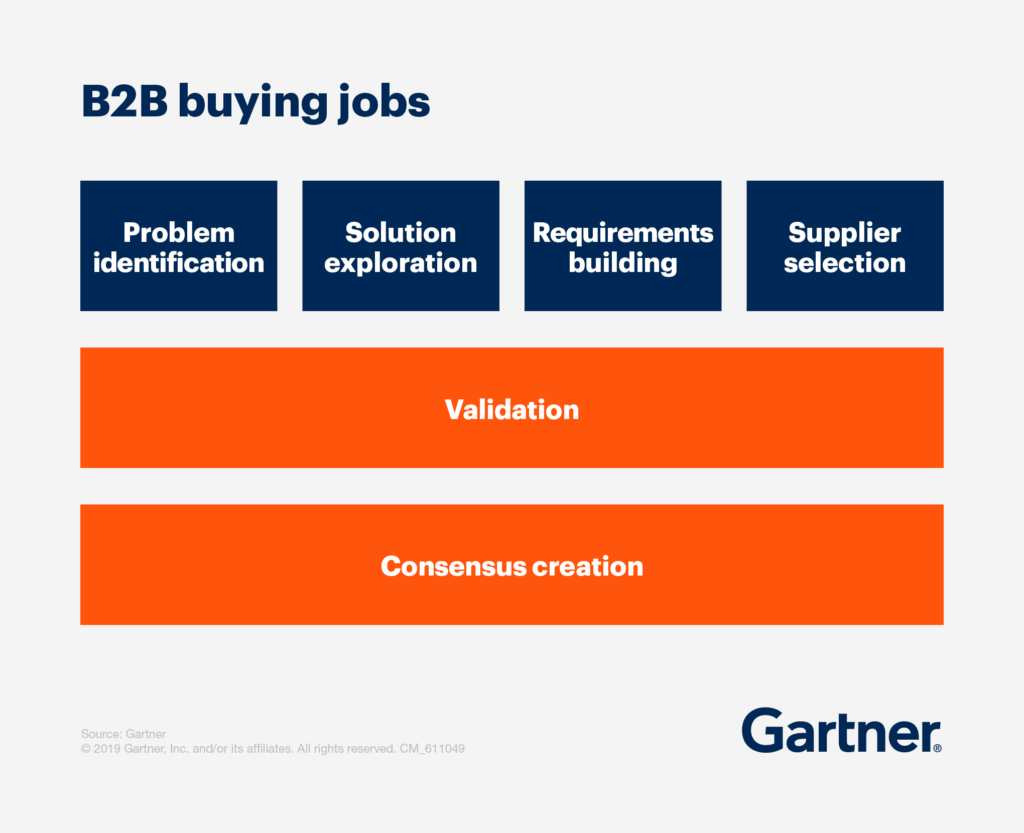
Has the B2B buyer journey changed? We chatted with Pius, the Head of Growth at Lumen5 and discussed the power shift from the company to the buyer. And here’s what he has to say:
Historically, Sales was in charge of 80% of your awareness and consideration initiatives in your sales funnel. From knocking on your door or cold-calling, to handing out physical brochures and being the face and biggest advocate for your B2B company. And the one true source of knowledge: competitors, features, company information – everything! But now that’s not so true.
As digital communications is exploding, buyers no longer rely on sales reps to be the “one true source of knowledge”. Only 29% of buyers want to talk to a salesperson to learn more about a product – including B2B buyers. Nowadays, information on a company can be found everywhere and anywhere. When purchasing, 92% of B2B buyers start with an information search and 75% depend on social networks to learn more about choosing the right vendor. Causing a shift in power and information consumption, leaving Marketing to rise to the challenge of the Internet and its gift to us all: highly shareable, searchable, and accessible content – all at our fingertips.
Recognizing the B2B buyer’s mindset has changed, BUT not their psychology or behaviour.
“Buyers are more and more doing the majority of their own research outside of connecting with actual vendors … So that means, by the time they get to sales, they’ll already have majority of the information they need to make a decision.”
– Pius Chan, Head of Growth at Lumen5
The power of buying and information has shifted as B2B buyers take themselves through their own customer journey. Buyers are no longer travelling through a one directional, one dimensional customer journey, but travelling in a “loop”: a multi-directional, 3-dimensional customer journey. One where they come in onto the path when and where they like, but also travel at their own pace.
59% of buyers prefer to do research online instead of interacting directly speaking with the sales rep. And most often enough, potential buyers are 2x more likely to discover your products by searching the web or via social media. And although this is great awareness, there are also fewer opportunities to influence customer decisions. So how can marketing help B2B buyers along in their customer journey? Notice the keyword: HELP. (not sell)
Marketing Strategies to Engage and Consider
1. All messaging should be helpful, not sales-y.
– Pius Chan, Head of Growth at Lumen5
57% of buyer decisions are made before buyers even pick up a phone to speak to a vendor. In fact, 60% want to engage with a sales rep AFTER they’ve researched their options. The best B2B companies are positioning themselves as thought leaders – guiding B2B buyers through every step of the journey. And guess what? 95% of buyers choose the company that provides them with ample content to help navigate through each stage of the process.

Gartner breaks it down into 6 stages:
- Problem Identification: “We need to do something about this problem.”
- Solution Exploration: “What’s our there to solve our problem?”
- Requirements Building: “What exactly do we need the solution to do?”
- Supplier Selection: “Does this do what we want it to do?”
- Validation: “WE think we know the right answer, but we need to be sure.”
- Consensus Creation: “We need to get everyone else on board.”
By providing more middle funnel content, such as practical support and advice videos, that address B2B buyers pain points and supports the completion of all their JTBDs (jobs to be done), 68% of buyers feel a much more positive feeling after reading useful content. And thus, will likely lead to a purchase where B2B buyers are confident and experience a higher degree of purchase ease.
2. Create consistent content that resonates.
90% of B2B buyers admit that online content has a moderate to major effect on their purchasing decision. And we should care, why? Well, during the exploration and researching part of the B2B buyer journey, buyers are looking for that one source that is credible, reliable, and trustworthy. Whether it’s through social media or your own company’s blog, releasing content consistently can position your company as reliable and stable – something decision makers or buyers look for.
However, make sure to create content that is engaging and resonates, addressing their main concerns. And if backed with data and analytics, can also guide B2B buyers to making an informed purchase decision. This increases the likelihood of a high-value, low-regret deal by 3 times!
“Don’t market your company because no one cares – to be honest – about your company. Everyone cares about the problem and pain you can resolve, because they feel it too.”
– Pius Chan, Head of Growth at Lumen5
Some quick tips and tricks:
- Make your customers the hero of your content (videos, blogs, podcasts, etc.)
- Give your brand a face that the audience can relate to
- Present common issues, questions, or concerns the audience may experience, and explain how to overcome them
- While creating content, consider what stage of the funnel you’re at, and what emotions you want to inspire
Another useful tip is to create videos, such as customer testimonies or case studies. These types of videos can create instant reactions, making your video much more relatable. You’re able to trigger emotions through visuals, audio, and words, communicating and connecting with your audience on a variety of levels while greatly deepening trust in the process. Simply put, emotional storytelling resonates with buyers’ problems while providing viable solutions.
How the Sales Approach Needs to Change
Become a channel, not the channel.
Surprisingly, only 17% of the entire B2B buying process is spent meeting with potential companies – crazy right? Sales’ role has shifted from the holder of information to the person who customizes the solution to fit that specific use-case. Sales no longer handles the “awareness” aspect of the funnel, but now towards the latter end of the “consideration” stage. However, they are still the first direct human interaction this B2B buyer will have – so be sure to make the right first impression. dun-dun-dun-dun!

This becomes a skilled and strategic game of nurture. Adjusting their mindset to match the B2B buyers’ at this time and becoming empathetic by listening to the specific needs of the B2B buyer can help with providing ONLY relevant information. And 68% of B2B buyers agree that they are more likely to buy and feel more comfortable from this approach! Sales needs to figure out how to nurture B2B buyers out of the continuous awareness and consideration loop, but it’s not always as easy as 1-2-3. However, 57% of B2B buyers admitted they’d prefer to purchase from a sales person who doesn’t try to apply pressure or hassle them when following up. It may seem like the greatest test of patience, but it’ll definitely be worth the wait!
Some tips to consider:
- Be understanding: change messaging from “hey, check out our great product” to “I hear you and understand your specific pain points, have you considered this?”.
- Be intentional with touch points: don’t just follow up for the sake of it! Remember, we’re here to help NOT sell!
- Provide additional relevant information: re-share any marketing content that addresses their issues or provides customer validation – over 80% of B2B buyers view at least 5 pieces of content before choosing a vendor
- Be human and connect: remember, B2B buyers are humans too!
– Pius Chan, Head of Growth at Lumen5
Today, your focus should be on your customers. Curate the B2B buyer’s journey with content that’ll help their purchase decision. Realize that there is no “one size fits all” and that’s not what B2B buyers are looking for anymore, is the first step.
“That journey of buying hasn’t changed. But who manages what and how we manage has changed with the advent of technology and the evolution of communication and digital.”
– Pius Chan, Head of Growth at Lumen5






